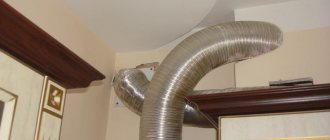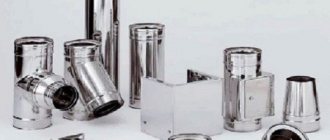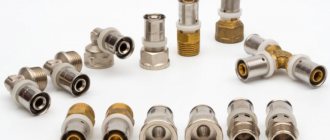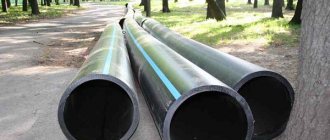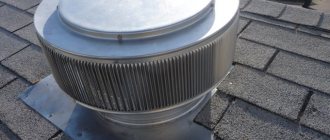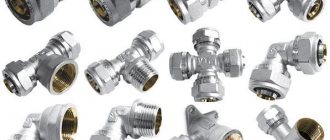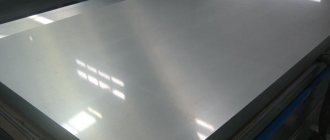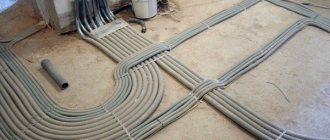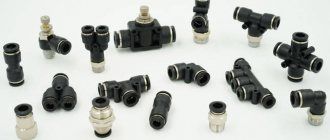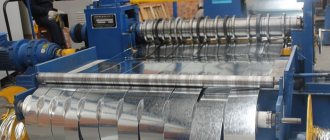Stainless steel pipes used for the installation of water supply and heating systems have a number of advantages when compared with products made from conventional carbon steels. These advantages include durability (which can reach up to 400 years), as well as the hygiene of the material.
Stainless steel water supply: reliable and beautiful
In addition, the internal diameter of pipes made of stainless steel does not decrease over time due to the accumulation of oxidation products on their internal walls (and, naturally, such products do not get into the water supplied through the pipes, which is especially important for domestic water supply). That is why stainless steel pipes are increasingly being replaced by products made from conventional carbon steels, which, due to active oxidation, can last no more than 10–15 years.
Purpose of stainless steel fittings
Stainless steel pipe products are widely used for the installation of pipelines for various purposes. But if steel pipes are inferior in some properties to polymer and hybrid ones, then stainless steel shaped elements still remain indispensable in a number of cases.
Steel fittings are designed for the following tasks:
- connections of pipes made of metal, plastic and metal-plastic;
- making a transition between pipeline elements made of different materials;
- transition between pipes with different parameters (section, method of fixation);
- connecting supply and consumption devices to the main pipeline;
- making pipe network branches;
- shutting off pipes that are temporarily not functioning;
- changes in pipe direction.
One of the areas of application for stainless steel fittings is the installation of domestic gas pipelines, heating systems, water supply networks, as well as industrial pipelines transporting various working media, including aggressive ones. Steel shaped elements are used to organize dust and gas exhaust systems.
Step-by-step assembly of a chimney in a house
The correct operation of the boiler largely depends on the quality installation of the chimney.
Assembly algorithm:
- A tee with a condensate collector and an inspection is connected to the nozzle of the heating unit.
- Holes are cut: round or square in the attic floor, oval or rectangular in the roof.
- The pipe is increased to the required height. At the ceiling level, a ceiling-passage device is put on it, which is fixed in the ceiling and filled with thermal insulation. In an opening cut into the roof, the chimney must also be insulated.
- After passing the hole in the roof, a special “skirt” is put on the pipe, which is needed to protect it from leakage. The base of the “skirt” is fixed to the roof. The top of the pipe is equipped with a deflector to protect it from rain, wind and clogging. If the roof is made of flammable materials, an additional spark arrestor is installed.
- The joints are tightened with clamps and treated with sealant; if necessary, the structure is strengthened by securing it with brackets inside the attic.
Outdoor installation
- Mark the location of the chimney in the wall and cut a hole taking into account the thermal insulation.
- Connect the passage pipe to the pipe of the heating device and lead the chimney to the street. Isolate the passage of the wall.
- Attach a tee with a dropper and an inspection to the removed pipe.
- Raise the chimney up to the required height; if necessary, fix the structure with a bracket every two meters. The joints are tightened with clamps and covered with sealant. A conical nozzle - a deflector - is attached to the top of the pipe.
- Cover the chimney with a protective compound to prevent rust from forming.
- If the structure is made of single-layer pipes, insulate along the entire length.
Features of stainless steel connecting fittings
Steel fittings are structurally little different from analogues made from other materials. Conventionally, we can distinguish within any shaped element a body corresponding to the function it performs, and pipes with fasteners.
The popularity of stainless steel connecting fittings is due to a set of positive qualities characteristic of steel, as well as a large selection of connecting parts.
Advantages and disadvantages
Stainless steel reinforcement has many advantages over analogues made from other metal alloys and polymers:
- high mechanical strength,
- resistance to high temperatures,
- environmental friendliness,
- almost zero chemical activity,
- corrosion resistance,
- compatibility with most materials,
- non-flammability,
- variability in the design of the body and fasteners,
- ease of use.
Note! Stainless steel fittings, unlike their black steel counterparts, can even be used to connect copper pipes.
The service life of stainless steel products deserves special attention - 20-30 years, and some manufacturers provide a guarantee of even 40. When compared with analogues made of black steel, which last only 10 years, this is an undoubted advantage. But in comparison with plastic and cast iron counterparts, which have a service life of half a century, stainless steel definitely loses.
There are few disadvantages to shaped stainless steel elements:
- inability to form a tight connection without additional sealing agents;
- possible loosening or, conversely, sticking of dismountable joints, which is why the units require regular maintenance;
- large, especially compared to plastic analogues, weight;
- high price.
We recommend that you read: Advantages and disadvantages of cast iron fittings
Types of fittings
Stainless steel shaped elements are very diverse in terms of body type and tasks performed, fitting manufacturing method, and fastening options.
Note! The shape of the body and the functions of the connecting fittings are interrelated, that is, fittings designed to perform different tasks have different structures.
According to these characteristics, they are divided into the following types:
- Straight ones, called couplings and bends. They are used to connect identical pipes located on the same line. The coupling has a short body sufficient to connect elements of the pipe network, the pipes of which are located nearby. A bend - an elongated coupling or a section of pipe with fasteners at the ends - is needed to compensate for the distance between the connected elements.
- Transitional, these include gearboxes and fittings. The purpose of these fittings is to connect two pipes whose characteristics differ. The reducer allows you to organize a transition between pipes with different sections or different fasteners; accordingly, the pipes of such an adapter differ either in diameter or in the method of fixation. A fitting is an additional part that is used to form an assembly of pipes made of different materials. One of the fitting pipes is elongated and can be smooth, ribbed or notched - it is inserted into a polymer or metal-plastic pipe. The second pipe allows you to connect the resulting structure to another pipe, usually metal, using a coupling.
- Angular, called bends or corners. The body of such a fitting is curved, the bending angle varies from 90 to 165 degrees, and the radius of rotation depends on the diameter of the pipes.
- Branching - tees and crosses. The tee body is a coupling with a side branch, which can be located at an angle from 15 to 90 degrees to the axis. The crosspiece differs from the tee in the large number of additional pipes and in the fact that they are always located only at right angles to the main axis. Branch fitting pipes can be the same or different sizes. Such shaped elements are used to connect or cut the flow of the working medium in the pipeline.
- Sealing, called plugs. Plugs are necessary to shut off pipeline pipes that are temporarily not in use.
Classification by manufacturing method and fixation method
Fitting bodies can be one piece with mounting pipes; such products are considered the most reliable due to the simplicity of the design and the absence of additional connections.
There are also dismountable shaped fittings, in which not only the fastening elements, but also parts of the body can be detached.
Note! Collapsible fittings are much more expensive than solid fittings, but they are easier to install and are indispensable when carrying out work in hard-to-reach places.
According to the method of manufacturing the body, stainless steel fittings are also divided into:
- seamless - cast entirely, due to which it has no weak points, but also costs more;
- welded - individual parts of the body are cast, which are then connected by welding; the strength and durability of such a fitting depends on the quality of the seam, since it is this that experiences the greatest loads during operation of the unit.
We recommend that you read: Stainless steel ball valves in Khimki
According to the fixation method, they are distinguished:
- Threaded. The cheapest and simplest connecting fittings have external or internal threads on the pipes. To connect a pipe and a fitting, it is enough to twist them together using an adjustable wrench, having previously wound tow or FUM tape onto the external thread of one of the connected elements. The result is a dismountable unit that is easy to dismantle, and the fitting can be reused.
- Flanged. The connecting pipes of the fittings are equipped with flanges - transverse platforms with holes. To connect pipeline parts, their flanges are combined, having previously laid a sealing ring gasket between the platforms, and then tightened with bolts. A collapsible unit is formed, which, due to its massiveness and large size, is usually used on large domestic and industrial pipelines.
- Crimping. The connecting pipes of such fittings are threaded and a crimp nut is included. The nut is put on the pipe, then the threaded part of the fitting is inserted into the end of the pipe, after which the compression nut is tightened, rotating it along the resulting structure towards the body. The resulting connection is conditionally permanent, although the fitting can be reused after dismantling.
- Press fittings. The design of such shaped fittings is similar to crimp fittings, but instead of threaded pipes, the fitting body is equipped with smooth or ribbed fittings, and the fixing element is a press ring. The mechanism for making the assembly is also similar to crimping, but crimping the ring requires special press pliers. After fixing, a reliable one-piece unit is obtained.
- Welded. A distinctive feature of welded fittings is the absence of a fastening element on the body. The fitting and pipe are paired using welding equipment - the ends of the products are heated and fused together. The resulting assembly is reliable and sealed, but it can only be completed by connecting identical materials, so welded fittings are only suitable for stainless steel pipes.
- Combined. Such fittings are reducers - adapters between pipes that differ in the method of fastening. Most often, combined couplings are those that have different fasteners on different pipes.
Threaded and flanged fittings also differ in flow capacity. Threaded fittings are produced with a diameter of up to 16.3 cm, since with a larger cross-section, vibration of the working medium gradually unwinds the thread, making the assembly leaky.
Flange fittings are produced with a diameter of 5 cm, since small flanges are difficult to install.
Crimp and press fittings are suitable for connection only with elastic pipes, which, after deformation, tend to restore their original shape and fill the gaps between the fitting parts, making the assembly airtight. On rigid pipes, when using crimp or crimp fittings, cracks and chips form.
We recommend that you read: Types and rules for installing sewer fittings
Information to note
When giving information about installing water lines, it should be noted that corrugated stainless pipe is a universal solution not only when it comes to water. Here is just a basic list of those areas in which it is still applicable.
- If we first talk about water, then this is not only the supply to the taps. Almost all apartments already have water consumption meters. Yes, we are talking about counters. Often their installation takes place in inconvenient places, and even in limited space. Plus, it is necessary to take into account the requirements of utility companies and the manufacturer, which recommends two installation positions - vertical or horizontal. And here the corrugation will save you time, money, nerves, and will also allow you to optimally fit into the available area, albeit limited for installation.
- In the bathroom, you can construct an excellent heated towel rail from this pipe (very often this is exactly what is done).
- Heating. There is also versatility here.
- warm floor. A fairly safe technique for pouring then mortar laid according to the communication scheme,
- When installing individual heating, gas services require that the pipe from the central line in the apartment directly to the boiler be made of metal. The technology of the process was such that most often it was necessary to bend an ordinary steel pipe and connect it on one side by welding, and on the boiler side with a special flexible connection. The procedure is labor-intensive and requires a welding machine, a pipe bender, a specialist and a considerable amount of time and endurance.
The properties of a stainless pipe (corrugation) make it possible to avoid all these nuances without violating any fire regulations or safety requirements. The pipe is metal and can be installed by manually shaping it according to the approved heating installation project and at the distance required (without restrictions). With the use of this particular material, the issue is closed from an aesthetic point of view as well.
- It is used in fire alarm equipment, all kinds of wiring, and is also used as a casing for laying any cables (often electrical).
Main manufacturers
It is better to purchase any shaped elements in specialized stores that are official dealers of manufacturers. This will protect you from buying a fake, the actual quality of which is much lower than that stated by the seller.
There are many manufacturers of connecting fittings, but there are time-tested and recommended by experts:
| Manufacturer's name | A country | Year of foundation | Range of stainless steel products |
| AWH | Germany | 1900 |
|
| Eurobinox | France | 1982 |
|
| Genebre | Spain | 1981 |
|
| Niob Fluid | Czech | 1992 | fittings for the food industry:
|
Features of use
Whatever type of fittings are used, no matter how well-known their manufacturer is and how high their price, the reliability and durability of the units can only be ensured by shaped elements with proper installation and careful operation.
Rules for installation and use:
- When purchasing fittings, you should familiarize yourself with the conditions of their storage, transportation and operation and make sure that the products themselves and their packaging are not damaged.
- Stainless steel shaped elements should be stored in a dry and warm place so as not to prematurely start the aging process of steel.
- Do not use connecting fittings that have damage to the body or fasteners - this can lead to blockage of the unit, increased load on it and an accident on the pipeline.
- The pipes to be connected are cut strictly transverse to the axis and the cuts must be leveled, burrs removed and ground so that during operation the working environment does not encounter obstacles and the quality of the connection does not deteriorate.
- Before installation, the mating surfaces of pipes and fittings must be cleaned of dust and debris and degreased so that foreign substances do not violate the tightness of the connection. Stainless steel fittings can be washed, but only with warm water. The use of chlorine-containing cleaning agents and detergents is not permitted.
- The connected pipeline elements are always aligned in a straight line, so that their axes coincide. Distortions that arise during installation can lead to depressurization of the unit, damage to the fitting and pipes.
- Fittings must not be installed under tension, since due to thermal expansion and contraction and operational vibration of the pipes, such a unit may leak. Sagging of the connection node is also unacceptable.
- Threaded and flange type fittings are installed only for open installation, welded fittings are installed mainly for hidden installation.
It is important! Detachable connections require periodic maintenance - tightening the bolts holding the flanges together, tightening the threaded fittings; sometimes it is necessary to dismantle the unit and replace the sealing gaskets. Permanent connections do not require maintenance.
Possibility to do it yourself
Both in new housing and in an old apartment, well-being in terms of communal amenities depends on how well the fundamental work was done. This refers to the laying of electrical cables, heating systems, water supply and sewerage communications. In our case we will talk about water pipes.
It’s good when all of the above is done by specialists using modern developments, tools and professional skills to ensure the quality of installation of various life support lines.
Stainless steel pipes
However, these same modern technologies and developments, a wide range of materials make it possible to replace the pipeline with your own hands. Of course, for this it is necessary to carry out preparatory work to familiarize yourself with information about available new products, installation methods. Also purchase pipes and connections for them.
Most often, a certain set of tools is already present in the house, and you only have to buy materials.
